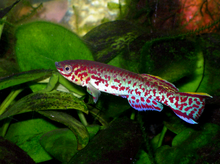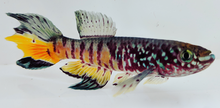
George Albert Boulenger was a Belgian-British zoologist who described and gave scientific names to over 2,000 new animal species, chiefly fish, reptiles, and amphibians. Boulenger was also an active botanist during the last 30 years of his life, especially in the study of roses.
George Sprague Myers was an American ichthyologist who spent most of his career at Stanford University. He served as the editor of Stanford Ichthyological Bulletin as well as president of the American Society of Ichthyologists and Herpetologists. Myers was also head of the Division of Fishes at the United States National Museum, and held a position as an ichthyologist for the United States Fish and Wildlife Service. He was also an advisor in fisheries and ichthyology to the Brazilian Government.
Nothobranchius jubbi is a species of killifish in the family Nothobranchiidae. It occurs in north eastern Africa in Kenya, Somalia and Ethiopia in temporary pools, ditches, marshes and rain pans, normally ones without any connections to rivers. This species was described in 1979 by Rudolf Hans Wildekamp and Heinz Otto Berkenkamp with the type locality given as a pool on the road to Garsen, 17 miles north of Malindi. The specific name honours the South African meteorologist and ichthyologist Reginald A. "Rex" Jubb (1905–1987) of the Freshwater Fish Section at the Albany Museum in Grahamstown, South Africa, in recognition of his taxonomic work on the genus Nothobranchius.
Nothobranchius neumanni is a species of killifish in the family Nothobranchiidae. It is endemic to Tanzania. It occurs in both perennial and seasonal wetlands including rivers, lakes and ponds where it most likely feeds on planktonic crustaceans. This species was described as Fundulus neumanni by Franz Hilgendorf in 1905. The specific name honours Hilgendorf's companion on some of his expeditions to Africa, the German ornithologist Oscar Neumann (1867-1946).

The blue notho, or Patrizi's notho is a species of killifish in the family Nothobranchiidae. It is found in Kenya and Somalia. Its natural habitat is running water. The males are usually around 5.0 centimetres (2.0 in). In the aquarium the females lay their eggs on bottom peat. This species was described as Fundulus patrizii by Decio Vinciguerra in 1927 with a type locality of the Harenaga swamps, near mouth of the Juba River in southern Somalia. Vinciguerra gave this fish the specific name of patrizii in honour of the collector of the type Saverio Patrizi Naro Montoro (1902-1957), an Italian explorer, zoologist and speleologist.
Nothobranchius steinforti is a species of killifish in the family Nothobranchiidae. It is endemic to Upper Wami River drainage, Tanzania. Its natural habitat is intermittent freshwater marshes, pools and rice fields. This species was described in 1977 by Rudolf Hans Wildekamp with the type locality given as "8 kilometers from Kimamba, Tanzania". The specific name honours the Dutch aquarist Theo Steinfort who helped collect the type and bred this species in captivity, making it available to other killifish hobbyists.

The blue lyretail, also known as the Gardner's killi and formerly as the steel-blue aphyosemion, is a species of killifish. It is endemic to freshwater habitats in Nigeria and Cameroon.
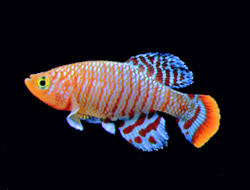
Nothobranchiidae are a family of bony fishes containing roughly 300 species, also known as African rivulines. They are small killifish, usually measuring about 5 centimetres (2.0 in). They are limited to Africa, living in fresh water but being also somewhat salt-tolerant. They are also found in muddy or brackish water. Some species are kept as aquarium pets. They have frilly fins and many are brightly colored. They were formerly included in the family Aplocheilidae ; a return to that broader family has recently been suggested.

Aphyosemion is a genus of African rivulines endemic as the name indicates to Africa. Many of these species are popular aquarium fish.
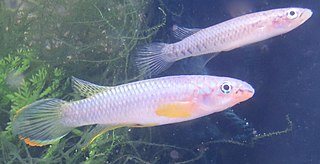
Epiplatys is a genus of African rivuline in the family Nothobranchiidae endemic to Africa as the name indicates. Several of these species are popular aquarium fish.
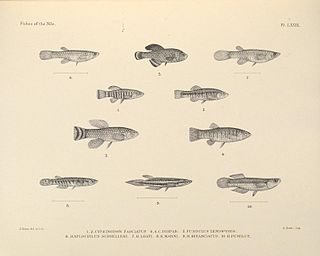
Micropanchax is a genus of poeciliids native to Africa.

Fundulopanchax scheeli, the emerald aphyosemion, is a species of killifish, endemic to the lower Cross River basin in Nigeria. It is a coastal rainforest fish which lives in small streams and ponds. It prefers a temperature of around 75 °F (24 °C), and a slightly acidic pH around 6–7. The specific name honours the Danish count, army colonel, explorer and ichthyologist Jørgen J. Scheel (1916–1989). F. scheeli grows to a maximum size of 6 centimetres (2.4 in) total length. It is considered to be critically endangered by the International Union for Conservation of Nature due to its very small area of occupancy and faces threats from herbicides and pesticides used in agriculture, such as in rice farming, and from deforestation.

Anatolichthys danfordii, the Kızılırmak toothcarp or Sultan Sazlığı toothcarp, is a species of killifish belonging to the family Aphaniidae. It is endemic to the Kızılırmak River and the upper Seyhan River drainage systems and is now restricted to a few locations in the Sultan Sazlığı marshes. Though little data is available, the population of the fish seems to be declining. The International Union for Conservation of Nature has rated its conservation status as being "critically endangered" and fears it may become extinct in the wild if the drainage of the marshes continues.

Aphyosemion bivittatum is a species of freshwater fish belonging to the family Aplocheilidae. It is found in rivers in southeastern Nigeria and southwestern Cameroon. It was originally described as Fundulus bivittatus by Swedish zoologist Einar Lönnberg in 1895. The holotype was discovered near a waterfall in the Ndian River in Cameroon and currently is located in the Stockholm Museum.

Aphyosemion australe, the lyretail panchax, golden panchax or Cape Lopez lyretail, is a species of freshwater fish belonging to the family Aplocheilidae. It is found around Cape Lopez and in surrounding areas in Gabon.

Fundulus luciae, the spotfin killifish, is a member of the genus Fundulus. This hardy fish is notable for spending its entire life in sporadically flooded salt marsh habitat, sheltering in shallow pools, puddles, and small tidal rivulets. It closely resembles the mummichog in shape and coloration, but the two species can be distinguished by dorsal fin ray count: 8–9 in the spotfin versus 11–12 in the mummichog. Additionally, the dorsal fin of F. luciae originates farther back, and slightly behind the anal fin origin; in the mummichog, the dorsal fin begins anteriorly to the anal fin origin. The spotfin killifish is named for the pronounced ocellus found on the posterior dorsal fin of adult males. It is a small fish, seldom attaining 50 millimetres (2.0 in) in total length. Its distribution extends along the U.S. east coast from Massachusetts to Georgia.

The Seminole killifish is a fish of the genus Fundulus, endemic to the U.S. state of Florida.
Jørgen Jacob Scheel was a Danish aristocrat, soldier, explorer and ichthyologist. His father was Jørgen Carl Scheel (1874-1944) and his mother was Erikka Ellen Estrup (1891-1960); his parents married in 1912. He was baptized in the Marie Magdalene Church in Sønderhald. Scheel was a landgrave of the Danish aristocracy.
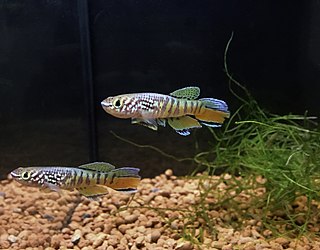
Fundulopanchax sjostedti, the blue gularis, golden pheasant gularis or red aphyosemion, is a species of toothcarp endemic to the Niger delta. It is only found in Nigeria and Cameroon.
Epiplatys grahami is a species of killifish in the family Nothobranchiidae. It is an African rivuline that is native to the fresh water habitats from south-eastern Benin and through southern Nigeria and Cameroon to north-western Equatorial Guinea. This species reaches a length of 7.0 cm (2.8 in).
